For many generations of Pittsburgh Pirates fans, Pirates history began in 1909 when the team moved into Forbes Field in Oakland. Others look back no farther than Three Rivers Stadium, built in 1970, and future generations will undoubtedly only be familiar with PNC Park, opened in the spring of 2001. Some of the earliest Pirates baseball, however, was played almost on the exact site where PNC Park stands today—and with decidedly more success than today's Bucs.
Exposition Park stood on the north shore of the Allegheny River across from downtown Pittsburgh, facing what has become the Point. The park was located about two blocks west of where PNC Park stands today at the intersection of South Avenue and School Street, with left field bounded to the south by the Baltimore & Ohio Railroad tracks.
Three rebuilt versions of Exposition Park housed various Pittsburgh baseball teams from 1882 until 1915, with the National League's Pittsburgh Pirates using the field from 1891 to 1909. The first Exposition Park, (also called the "Lower Field" and built on the exact location of Three Rivers Stadium) opened in 1882 and housed the Pittsburgh Alleghenies (later to become the Pirates) of the American Association for one season.
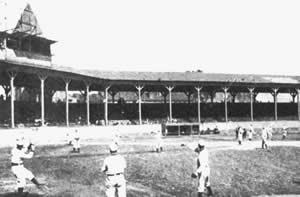
With flood control capabilities well in the future, a devastating flood left the Lower Field under water in 1882, forcing the opening games of the 1883 season to be moved to hastily built Exposition Park II (also called the "Upper Field"), on slightly higher ground. The Alleghenies played here for one year until flooding again forced the team to move several blocks away to Recreation Park, near present-day West Park, for seven years until the final version of Exposition Park was finished in 1890. The newly-named Pittsburgh Pirates of the National League took the field there for the first time on April 22, 1891. (The name was changed after the team "pirated" second basemen Louis Bierbauer from the Philadelphia Athletics).
The park was built in what was then the separate municipality of Allegheny City. While the city of Pittsburgh around it was booming with new technology and industries, Allegheny City remained antiquated, elegant and social--a perfect atmosphere for 1890s baseball. Frederick Mayer, in a June 1930 Pittsburgh Record article entitled "North Side: A Day in Old Allegheny," claimed that "Life must have been full of parties and entertainment. Money was spent freely and the social season lasted nearly all summer long."
While the new field was slightly better engineered, flooding was still a huge concern, with the Pirates routinely scheduling long road trips to avoid the floods of the Allegheny River. In his Pirates team history The Bucs! The Story of the Pittsburgh Pirates, John McCollister wrote "During the spring, when the snow melted and the rivers overflowed, sometimes the water would creep into Exposition Park, making the territory more appropriate for swimming meets than baseball games."
Built primarily of wood, the 16,000 seat stadium featured 400-foot foul lines and a 450-foot center field fence. Twin spires stood atop the roof of the grandstand behind home plate, often causing water to drench the field. On July 4, 1902, more than a foot of water covered the outfield and forced the Pirates to change the rules for the game—any hit into the outfield water was a single. Open bleachers ran the length of the first and third base lines, with standing room seating available in right field.
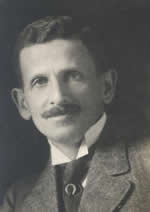
Exposition Park failed to house a winning team from the period between 1891 and 1899, with the Pirates finishing sixth, seventh, or eighth eleven times in the eight-team league. Times were about to change, however, when the Louisville Colonels folded in 1899 and Barney Dreyfuss, (recently inducted into the Hall of Fame), moved the team to Pittsburgh. Dreyfuss brought with him 14 players, among them all-time greats and Hall of Famers Honus Wagner and Fred Clarke.
Led by shortstop Wagner and his .329 career average and eight batting titles and left-fielder/manager Clarke, the Bucs claimed three straight National League pennants from 1901-1903. The National and newly-established American Leagues each staged separate championships at this time and often feuded bitterly.
Following a third straight NL title in 1903, Pirates owner Barney Dreyfuss and American League champion Boston's owner Henry J. Killilea agreed to compete in a best-of-nine game playoff series then dubbed "the Championship of the United States." The series was an effort to promote unity and "cool off" the rivalry between the two leagues. Exposition Park was to host Major League Baseball's first ever World Series.
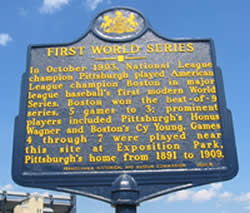
The first three games of the Series were held at the Huntington Avenue Baseball Grounds, home of the Boston Americans, with the Pirates winning two of the three games. The teams traveled back to Pittsburgh for Game 4 only to see Exposition Park yet again flooded by the Allegheny River. Louis P. Masur wrote in Autumn Glory: Baseball's First World Series that "the outfield looked like a frog pond and the infield a mud bath." Player/manager Fred Clarke was forced to call off the game, and rescheduled it for the next day.
The Pirates organization rented 2,000 extra seats from the circus and placed the seats in the outfield in anticipation of a huge crowd for Game 4, but the game only drew a meager 8,000 fans. Many believe the ticketholders for the postponed game the day before did not realize their tickets were still good the next day, resulting in the low attendance. The Pirates still managed to win the game and take a 3-1 series lead.
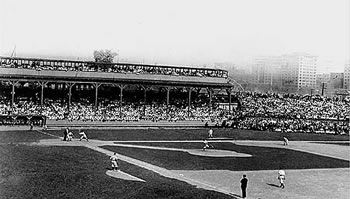
Game 5 drew the crowd to Exposition Park that the Pirates were anticipating. An estimated 18,000 fans arrived at the ballpark and despite the extra seating, Dreyfuss was forced to jam the overflow of fans behind makeshift ropes surrounding the outfield. The Pirates went on to lose Game 5 as well as Games 6 and 7 at Exposition Park before heading back to Boston, where they lost Game 8 and ultimately the World Series 5 games to 3.
The Pirates continued to have success in the next six years at the ballpark, although they never won another NL pennant there. The park did, however, go on to witness the franchise's first no-hitter, pitched by 20-year-old September call-up Nick Maddox in 1907 and six more Honus Wagner batting titles.
Flooding continued to be a debilitating issue for Exposition Park, and it became evident to owner Barney Dreyfuss that a new ballpark was a necessity. Dreyfuss later told the Pittsburgh Gazette-Times that "the game was growing up, and patrons no longer were willing to put up with nineteenth-century conditions." Dreyfuss believed he "had to get out of Exposition Park," and so decided on a scenic patch of land in Oakland to build was to become another historic ballpark: Forbes Field.
The last game at Exposition Park was played on June 29, 1909 in front of a meager 5,545 fans. The Pirates beat the Cubs 8-1, although they would lose to Chicago the next day in the first game at Forbes Field. In the game's last at-bat, "Taps" could be heard playing from the stands as the park's American flag was lowered for the last time.
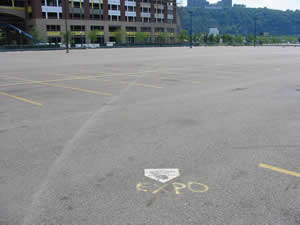
Time and construction projects had eroded the park's original site until 1995 when four members of the local chapter of the Society for American Baseball Research surveyed the area and decided to mark the exact dimensions of the park in what is today a PNC Park parking lot. They drove a nail into the ground where home plate stood, and proceeded to mark the plate and bases with spray paint. The paint has since faded slightly, but the location of the ballpark had been captured. A Pennsylvania Historical Marker was also placed at the site in September 1998, securing the legacy of a truly historic baseball venue.
Sources:
- Baseball Almanac. “1903 World Series.” 2000. 15 Sept. 2008 <http://www.baseball-almanac.com/ws/yr1903ws.shtml>.
- Frommer, Harvey. “The First World Series.” Baseballlibrary.com. 2008. IdeaLogical Co. 10 Sept. 2008.
- Lowry, Philip J. Green Cathedrals: The Ulimate Celebration of All 271 Major League and Negro League Ballparks Past and Present. New York: Addison-Wesley Publishing Co., 1992.
- Masur, Louis P. Autumn Glory: Baseball’s First World Series. New York: Hill and Wang Publishing Co., 2003.
- Mayer, Frederick P. “North Side: A Day in Old Allegheny.” Pittsburgh Record June 1930. Carnegie Library of Pittsburgh. 10 Sept. 2008 <http://www.clpgh.org/exhibit/neighborhoods/northside/nor_n44.html>.
- McCollister, John. The Bucs! The Story of the Pittsburgh Pirates. New York: Addax Publishing Co., 2002.
- Potter, Chris. “Was there a baseball field that the Pittsburgh Pirates played in before Forbes Field in Oakland?” Pittsburgh City Paper. 12 June 2008. 10 Sept. 2008. <http://www.pittsburghcitypaper.ws/gyrobase/Content?oid=oid%3A47798>.
- Powell, Albrecht. “History of Pittsburgh Pirates Baseball.” About.com. 2008. New York Times Company. 10 Sept. 2008. <http://pittsburgh.about.com/od/pirates/a/history.htm>.
- Ritter, Lawrence S. Lost Ballparks: A Celebration of Baseball’s Legendary Fields. New York: Penguin Group. 1992.
- “September 20, 1907-The Almost Perfect Recall.” Pittsburgh Post-Gazette 20 Sept. 2007: D1.
- Smith, Curt. Storied Stadiums: Baseball’s History Through its Ballparks. New York: Carroll and Graf Publishers, 2001.
